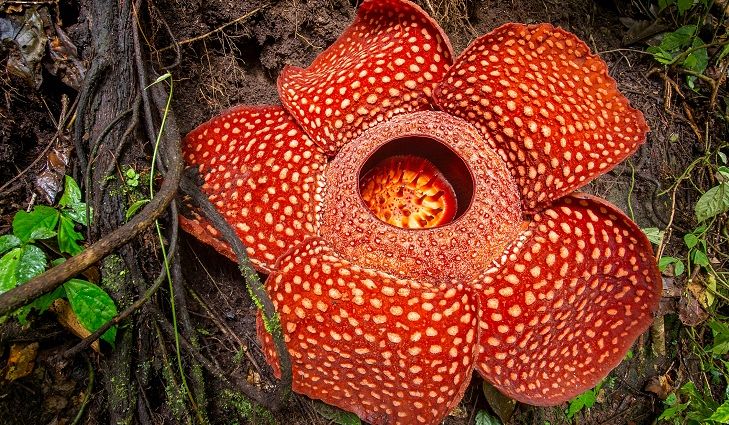Some of the world’s most interesting living things are ones we don’t even think about often due to their utilitarian nature. Frequently overlooked, oftentimes in a literal sense as they are below our line of sight, plants bring richness to our lives and to the general biodiversity around us. But there is much more to plants than the shrub outside your window or the tree on your sidewalk. Below we are presenting the seven strangest plants that wouldn’t be out of place even if we discovered it on an alien world.
Amorphophallus titanium: The Corpse Flower

Native to Indonesia, this plant would more readily be accepted as fictional than of actual existence. From the name alone, anyone can gather the eerie feeling that would send goosebumps crawling up your skin. Coupled up with the fact that the Amorphophallus titanium lets out a deadly wreak of actual rotting human flesh. As if that is not gut-wrenching enough, the flower is human-size, some even larger, and have their large petals modelled after the actual complexion of decomposing human flesh.
It is referred to as the Amorphophallus titanium, also known as the titan arum. The Indonesian locals refer to it as “the corpse flower” thanks to its natural adaptation to, for some weird reason, let out the unpleasant and nauseating stench of rotting flesh. The flower is the world’s largest inflorescence flower and is pollinated by the wild carrion-seeking insect.
Mimosa Pudica – The Shy Plant

If plants could develop some consciousness and if they could as well express or reserve some tangible feelings, then the Mimosa Pudica, Pudica translating to shy, would be one of those plants. Triggered by a slight touch, this plant’s compound leaves will retract inward while shyly drooping for a few minutes before reverting to normal as if to be shying away from physical contact.
The Mimosa Pudica has been identified as a pantropical weed even though it was found to have been native to South and Central America. Soliciting such an intuitive reaction from a plant by merely touching or gently shaking it is remarkably amazing. It is undoubtedly an adaptation that has probably contributed to the survival of this species for as long as it has.
Selaginella Lepidophylla: The Resurrection Plant

As the name would suggest, this plant can seemingly virtually die during the harshest of conditions only to come back to life when the environment is habitable again. The Selaginella Lepidophylla is also mythically referred to as the Rose of Jericho to suit its natural ability to survive near desiccation.
Native to the Chihuahuan desert, the Selaginella Lepidophylla’s stems will almost instinctively curl up into tight balls to preserve and optimally utilize its nutritional resources during the harshly dry conditions. In contrast, during wet conditions, the stems will spring back to life uncurling to adequately replenish its valuable reserves for when conditions get tight again.
Euphorbia obesa: The Baseball Plant

The same way wild animals like the tiger are facing a species-threatening foe in cruel poaching and human encroachment in their natural habitat, the Euphorbia Obesa was threatened by widespread and unsustainable harvesting by intrigued and curious plant collectors.
Native to the vast Karoo region of South Africa, the Euphorbia Obesa is now widely cultivated thanks to both national and international intervention in enacting protective legislation for the remaining wild Baseball plant population. This has ensured that no Euphorbia Obesa plant specimens sold amongst plant collectors are not from the wild.
Rafflesia Arnoldii: World’s Largest Flower

Anyone who loves flowers knows that they are most beautiful when they are at full blossom. Well, not this flower. The Rafflesia Arnoldii is the last flower you would probably want to be around when it’s blossoming time comes. Much like the Amorphophallus Titanum, this giant flower is also referred to as the corpse flower by Indonesians where it is native to thanks to its rotting flesh mimicking stench.
Spanning an impressively wide 3ft across its diameter and astonishingly weighing in at anywhere between 15-24lbs, the Rafflesia Arnoldii is the world’s largest flower. Its putrefying smell, however, isn’t what anyone would want to smell from a flower, especially if it’s of this gigantic size.
Welwitschia Mirabilis: World’s Most Resistant Plant

If you thought the resurrection plant was impressive, then the Welwitschia Mirabilis will undoubtedly have you making second considerations. With an estimated lifespan of anywhere between 400 to an unassailable 1500 years, this native Namibian plant can go a mind-boggling 5 years without rain. Pretty insane huh?
The plant can grow to a length of 2 meters while spanning a diameter of up to 8 meters. Considering the harsh desert conditions the plant exists in, it is unsurprising that it is only composed of three essential yet inadequate parts, being 2 leaves, a stem and the roots. As if its survival nature wasn’t impressive enough, the Welwitschia mirabilis has been natively named Onyanga, which translates to Onion of the desert. The name is thought to be suited to the plants’ delicious taste.
Dracaena Cinnabari: The Dragon Blood Tree

Finally, a plant that oozes red sap that ancients of its native Socotra Archipelago considered to be of valuable use as medicine and dye. The Dracaena cinnabari, also known as the Dragon Blood Tree or the Socotra Dragon Tree, was first heard of when it was first described back in 1882 by one Isaac Bayley Balfour.
It is among the most remarkably intriguing plants found in Socotra Archipelago and is characterized by its umbrella-like physical appearance. Few trees have what it takes to survive in very harsh conditions, but the Dracaena cinnabari is built to brave these deadly conditions comfortably. Combined with the fact that there is red sap coming from within the tree, it is easy to see why this Socotra plant is otherwise referred to as the Dragon Blood Tree.


































